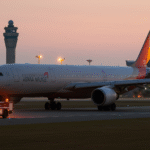U.S. Emergency Flights Begin as Iran Conflict Escalates: Global Travel Thrown into Disarray
As tensions in the Middle East explode into full-scale crisis, the United States has launched emergency evacuation flights from Israel. This dramatic move follows a series of precision U.S. military strikes on Iran’s most critical nuclear sites—Fordow, Natanz, and Isfahan—escalating the regional conflict and triggering widespread aviation disruption. For the travel industry and American citizens in the region, this is not just a geopolitical headline. It is a real-time emergency.
Evacuations Begin from Tel Aviv as Commercial Routes Collapse
In response to the deteriorating situation, the U.S. State Department coordinated its first wave of assisted departure flights over the weekend. Two chartered flights departed Tel Aviv’s Ben Gurion International Airport, bound for Athens, carrying approximately 70 American citizens, lawful permanent residents, and their families. The move signals an urgent shift in American foreign policy and travel strategy in response to Iran’s threats of retaliation.
With commercial airlines canceling services and Israel closing its airspace to non-military aircraft, the U.S. government’s decision marks a critical life-saving response for citizens stranded amid growing instability.
Middle East Airspace Shuts Down
Following the strikes, Iran, Iraq, Syria, and Israeli airspace have either been officially closed or rendered inaccessible due to safety concerns. The Federal Aviation Administration (FAA) and European Union Aviation Safety Agency (EASA) have issued Level 1 travel risk warnings, advising all airlines to avoid the entire region. This has forced commercial carriers to reroute long-haul flights between Europe, Asia, and Africa.
Airlines such as Lufthansa, Emirates, United Airlines, and Air France are now navigating around dangerous air corridors, using safer but longer flight paths over the Black Sea or via Egypt and Saudi Arabia. Flight durations have extended by hours, and air traffic controllers in alternate corridors are managing dangerously dense airspace.
Travel Disruption Spreads Across Continents
What began as a regional emergency is now rippling across continents. Rerouted aircraft are causing cascading delays at major international hubs including Frankfurt, Istanbul, Dubai, and New Delhi. Global carriers are issuing waivers for affected routes, but capacity for rebooking remains extremely limited due to peak summer demand.
In the U.S., travelers connecting to Asia and the Middle East from major airports like JFK, Atlanta, and Chicago O’Hare are seeing sudden cancellations and reassignments. International tourism to Israel and Iran has completely halted, while nearby nations like Jordan, Cyprus, and Turkey are bracing for a surge in diverted passengers and displaced tourists.
Strait of Hormuz Under Threat, Cruise Industry on Edge
Iran has hinted it may retaliate by disrupting maritime traffic in the Strait of Hormuz, the vital oil shipping channel that supports nearly one-fifth of global petroleum flows. The resulting uncertainty has spooked oil markets and sparked fears of fuel price hikes that could further drive up flight costs and logistical expenses.
Cruise operators with planned routes through the Red Sea and Arabian Gulf are now suspending operations or diverting to safer waters. Companies like MSC Cruises and Norwegian Cruise Line have already issued advisories to passengers and travel agents, warning of revised itineraries and possible cancellations.
Tourism Industry in Emergency Mode
The tourism industry across the Middle East is in crisis. In Israel, hotel bookings have collapsed, with tour operators canceling all incoming group travel. American tourists and students in the region are being relocated, with help from consulates and private security firms. The Israeli Ministry of Tourism has activated emergency response units to assist stranded foreign nationals.
Jordan and Cyprus are preparing for an influx of diverted flights and temporary visa requests. Hotels in Amman and Larnaca are already nearing capacity. Travel agents are racing to reroute clients or secure new bookings in unaffected destinations.
U.S. State Department Travel Warning Hits Level 4
The U.S. government has now raised its advisory for Israel, Iran, and Iraq to Level 4: Do Not Travel. Travelers still in the region are being urged to leave immediately using any available means. Commercial flight options are dwindling, and the U.S. warns that future assistance may be limited as conditions worsen.
The Smart Traveler Enrollment Program (STEP) is now the U.S. government’s key tool for tracking citizens abroad and issuing evacuation orders. Travelers in affected zones are urged to enroll immediately to receive emergency updates, instructions, and direct contact with embassy staff.
What Travelers Should Know and Do Now:
- If in Israel: Leave immediately if safe to do so. Apply for U.S.-assisted flights through the State Department crisis intake system.
- If traveling to the Middle East: Cancel or postpone your plans. Monitor airline updates and rerouting advisories.
- If flying long-haul to Asia or Africa: Expect longer routes, higher prices, and possible delays due to airspace congestion.
- Ensure your insurance covers war-related disruptions. Many standard policies do not.
- Stay informed through FAA, EASA, and State Department channels.
Aviation and Tourism Brace for Prolonged Impact
Industry experts warn that unless diplomacy intervenes, airspace closures could last for weeks—or even months—further upending airline schedules, cruise itineraries, and tourism flows. Airlines will likely face financial strain as fuel costs rise and customer service teams are inundated with refund and rerouting requests.
Meanwhile, the tourism economy in neighboring regions like Turkey, Egypt, Cyprus, and the UAE may feel secondary impacts as traveler confidence continues to erode.
Conclusion: A Crisis with Global Reach
The launch of U.S. evacuation flights from Israel underscores the gravity of the situation. This is no longer a localized military operation—it’s a global travel crisis. From grounded flights and stranded passengers to shifting geopolitical travel maps, the skies have become contested territory.
Travelers worldwide must remain vigilant, flexible, and informed. As the conflict evolves, so too will the routes, advisories, and realities of global mobility in 2025.
For more travel news like this, keep reading Global Travel Wire














